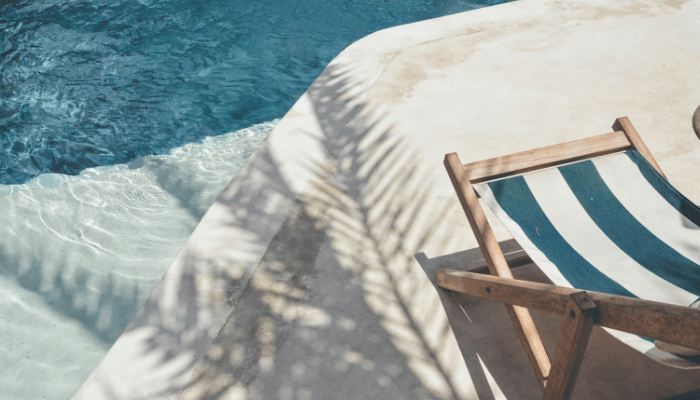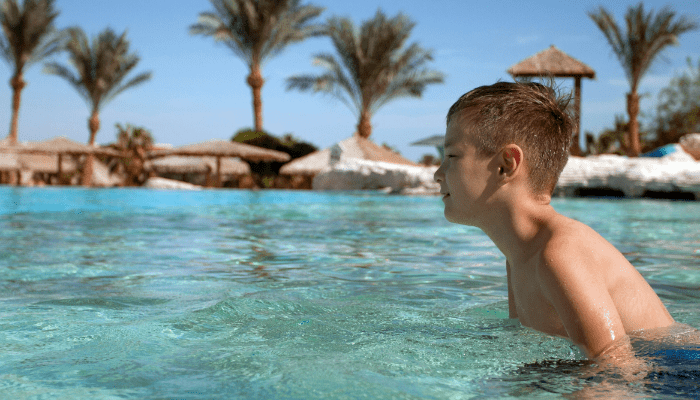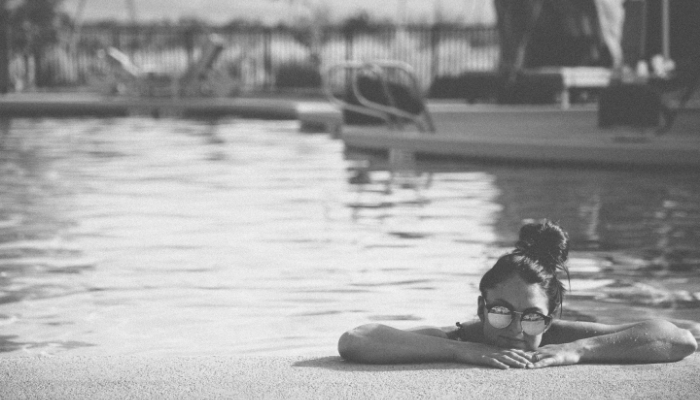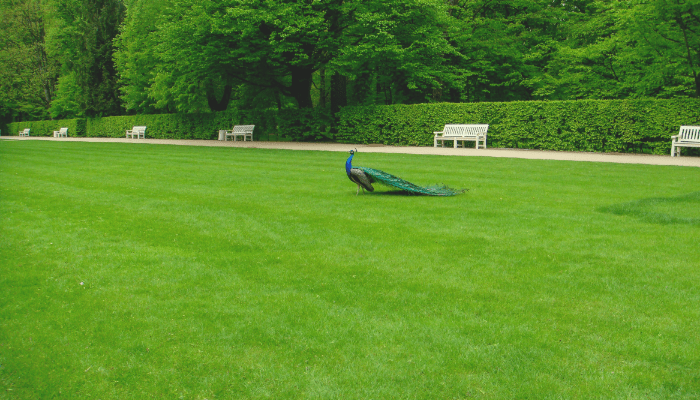Key Takeaways
- A healthy pool = balanced biology, smart filtration, eco‑friendly design.
- Chlorine pools = skin/eye irritation, heavy upkeep, chemical smell.
- Classic natural pools = small swim zones, murky water, high maintenance.
- Oásis pools = crystal clear, chemical‑free, self‑regulating ecosystems.
- Filtration uses gravity sump + UV + ozone for clean, safe water.
- Key metrics: ammonia, nitrites/nitrates, pH, turbidity.
- Optional test kits and smart monitors for easy tracking.
- Custom designs blend naturally into your landscape.
- Swim healthy, sustainably, and beautifully at home.

Let’s face it: we’ve come a long way from backyard kiddie pools and those sketchy motel pools that reek of mystery chemicals and sunscreen. These days people actually care what’s in the water, and that’s a good thing – because if we all love swimming for health, it’s gotta be healthy water we’re swimming in!
Thanks to growing awareness around health, sustainability, and what goes in and on our bodies, more and more people are asking:
“Is this pool actually safe to swim in?”
“What’s the deal with all the chemicals?”
“Why does my skin feel like I just bathed in a vat of Windex?”
Enter the concept of healthy swimming pools, a phrase you’ve probably seen tossed around on government websites like the CDC’s Healthy Swimming page, or from eco-conscious brands like ours. These resources focus on promoting better habits in and around swimming pools (like not swimming with a cold, rinsing off before entering the water, and of course no peeing, please).
But here’s the thing: behavior is only half the equation. The other half? The pool itself.
Because no matter how clean you are, if the water you’re swimming in is an under-filtered, over-chlorinated soup of synthetic compounds and invisible critters, then… yeah, that’s a problem.

What Actually Makes a Swimming Pool “Healthy”?
Good question. A truly healthy swimming pool isn’t just clear to the eye, it’s balanced, safe, sustainable, and kind to your skin, lungs, and the local environment.
Let’s break down what makes a pool actually healthy:
- Water Clarity: You should be able to see the bottom clearly, not just guess whether your flip-flop is down there somewhere.
- Chemical Balance: Water that’s not too acidic, not too basic, and not so chemically sterilized it could double as a medical tool rinse.
- Biological Stability: No rogue algae blooms, no bacterial explosions, and definitely no “is that mold?” moments.
- Eco-Friendliness: No toxic runoff, no overuse of energy, and no angry local frogs complaining about their habitat.
A pool that ticks these boxes is not only pleasant to swim in, it’s safe, low-maintenance, and sustainable. The kind of pool you can let your kids or dog jump into without needing a chemical shower afterward.
And guess what? You don’t need to settle for harsh chlorine or murky, plant-dense “natural pools” to get there!

The Hidden Costs of Traditional and Natural Pools
So now that we’ve defined what “healthy” should mean, let’s talk about what’s actually out there.
Chlorinated Pools (aka “chemical baths with floaties”)
We all know that classic pool smell. People say it smells like “clean,” but what it actually smells like is chloramines, a byproduct of chlorine mixing with body oils, sweat, and other things we won’t mention. Too much exposure to chlorine has been linked to skin irritation, eye redness, asthma, and even long-term respiratory issues in frequent swimmers.
And let’s not forget the maintenance. You’re constantly:
- Testing pH levels
- Adding chlorine or stabilizers
- Scrubbing algae
- Skimming debris
It’s exhausting. And expensive. You’re basically running a mini water treatment plant.
In short: you get a clear pool, but you also get dried-out skin, bleached swimsuits, and a persistent chemical cloud that follows you home.
Traditional Natural Pools (aka “beautiful, slightly swampy retreats”)
These pools look amazing in photos, gorgeous stonework, floating water lilies, dragonflies doing their thing. But when it comes to swimming? Let’s just say it’s a mixed bag.
In most European designs (Spain, Portugal, Germany), much of the pool is reserved for plants and only a small area for swimming, since the filtration relies almost entirely on plants and beneficial bacteria.
The result? Often murky water, lots of maintenance, and not a ton of actual space to move around in.
Natural pools sound great until you realize you’re basically wading through a plant spa.
Oásis Biosistema Pools: The Best of Both Worlds (and Then Some)
This is where we come in. At Oásis Biosistema, we thought:
Why not create a pool that has the natural balance of a pond, the clarity of a high-end spa, and the efficiency of modern filtration tech?
So we built it. And it’s beautiful.
“At Oásis Biosistema, our ponds are a unique blend—not quite a traditional pond and not exactly a natural pool, but something in between.”
Our hybrid pool-ponds are:
- Crystal clear
- Chemical-free
- Full of life (plants and fish)
- Filtration-forward (more on that below)
And designed to make swimming feel like a luxury nature escape, not a science experiment.
The Techy Magic Behind Our Clean Water
Ready to geek out a little? Let’s talk systems.
The Gravity-Fed Sump Filtration System
Our pool-ponds don’t rely solely on plants to do the heavy lifting. While aquatic plants play an important role, the real MVP is our gravity-powered sump filtration system. It works like this:
Water is pulled down into a hidden filtration chamber using gravity, no loud suction or disruptive pumps on the surface.
Inside the sump, the water passes through:
- Japanese mats (for fine filtration)
- Filter brushes (to trap larger debris)
- Specialized media (to host beneficial bacteria that break down gunk)
After being filtered, the water enters a submerged pump chamber, where it’s gently pushed back out into the swim zone through strategically placed return jets, ensuring constant circulation.
UV + Ozone = Water Wizardry
To give nature a high-tech helping hand, we use ultraviolet (UV) light and ozone treatment:
UV Light disrupts algae cells at the DNA level, stopping them from multiplying (basically zapping them into oblivion).
Ozone oxidizes organic waste, killing bacteria and breaking down microscopic nasties that would otherwise cloud the water.
Combined, they keep the water:
- Crystal clear
- Free of pathogens
- Smelling fresh, not fishy
And unlike chlorine, they do all this without chemical residue.

Water Quality Metrics: What We Actually Test For (And Why It Matters)
We get it, water should be clear, right? You look into your pond or pool, and if you can see the bottom, you’re good to go, right? WRONG. Water clarity is nice, but it’s not the full picture. You could have a pool so clear it looks like liquid glass, but still be swimming in a toxic brew of unseen nasties. Or, you could have a bit of cloudiness from a healthy microbial ecosystem, and that might be exactly what you want. Confused? Don’t worry, we’re here to break it down and explain what we actually care about when it comes to water quality and why it matters more than just “looks.”
The Basic Water Quality Parameters: What Are We Testing For?
We don’t just use a fancy crystal-clear aesthetic as a measure of quality. Here’s the list of metrics we actually test for to make sure your pool/pond is as healthy and balanced as possible:
Ammonia (NH₃)
What it is: Ammonia is a byproduct of fish waste, decaying plant matter, and any other organic material that’s in the water. It’s toxic in high concentrations.
Why it matters: Ammonia can be harmful to aquatic life and can cause skin irritation or worse if concentrations are high. Fortunately, our filtration system and natural biological processes help convert ammonia into less harmful compounds, like nitrates. But without a proper filter or ecosystem, ammonia can build up and create major problems.
Nitrate (NO₃)
What it is: Nitrates are the end product of the ammonia-to-nitrite-to-nitrate conversion process that happens in biological filtration (fancy word: nitrification). Nitrates are the “final” step in the nitrogen cycle.
Why it matters: Nitrates are less toxic than ammonia or nitrites, but at high levels, they can encourage algae blooms, which can make your water cloudy and low on oxygen. We like to keep nitrate levels in check to prevent overgrowth and to maintain balance in the system. Too much of a good thing isn’t always good.
Nitrite (NO₂)
What it is: Nitrites are the intermediary stage between ammonia and nitrates in the nitrogen cycle. It’s a less common metric we test for, but it’s crucial when you’re establishing your system or after any major changes to your pond.
Why it matters: Nitrites are toxic to fish and other aquatic organisms. High levels are typically a sign that your biological filtration is still establishing itself or that something in your filtration process has gone awry. Fortunately, nitrites usually don’t hang around for long if the system is functioning properly.
pH Levels
What it is: pH measures how acidic or alkaline the water is. The scale goes from 0 (very acidic) to 14 (very alkaline), with 7 being neutral.
Why it matters: The pH of your water affects everything from fish health to plant growth to the efficiency of your filtration system. If the pH is too low (acidic), fish may become stressed or even die. If it’s too high (alkaline), it can reduce the effectiveness of biological filtration and cause mineral imbalances. In an Oásis pool-pond, we aim for a slightly alkaline pH between 7.5 and 8.5. This supports healthy microbial activity and is ideal for both plants and fish.
Turbidity
What it is: Turbidity is a fancy term for how cloudy or clear your water is. It’s essentially a measure of how much solid material (like dirt, algae, or plant matter) is floating around in the water.
Why it matters: High turbidity means your pool-pond is full of suspended particles, and while it may not be immediately harmful, it does indicate that your filtration or biological processes might not be working at full capacity. We aim for low turbidity because clear water isn’t just pretty, it’s an indicator that everything is filtering properly, and the ecosystem is in balance. But don’t let the occasional natural cloudiness freak you out. Healthy ponds may have some visibility challenges, especially right after a storm or after plant trimming!
Why Crystal-Clear Water Isn’t Always Clean (And Vice Versa)
Now here’s where things get interesting. You’ve probably seen pools that are so clear you can see the individual grains of sand at the bottom. That’s nice, right? But hold up, just because the water looks clean doesn’t mean it is. Clear water could be full of invisible pollutants, like:
- Excessive nutrients (like nitrates or phosphates) that fuel algae growth.
- Toxins from pesticides, fertilizers, or run-off from nearby lawns.
- Fine particles that may pass through a basic filter but still pose a health risk.
On the flip side, some cloudiness can actually be a sign of a healthy biological system. Your pond might have a little bit of haze from beneficial microbes and plankton doing their job. It might look murky, but it’s more like a “living” pool that’s actively processing waste, kind of like how a healthy gut might be a little cloudy with bacteria but still totally functional.
At Oásis Biosistema, we balance aesthetic clarity with biological health. So, while we strive for clean water, we also prioritize a system where natural filtration and biological activity (like plant roots, fish, and microbes) are working in harmony to keep your pool-pond environment safe, sustainable, and low-maintenance.
How Oásis Designs Make Water Quality Self-Regulating
The beauty of Oásis Biosistema’s pool-pond design is that you don’t have to micromanage your water quality. Our system is engineered to make the pond’s ecosystem work as a self-regulating entity. The way it works:
- Biological filtration: The plants and microbes in the pond actively break down nutrients and waste, so the water doesn’t get overloaded with nitrogen and phosphorus (the nutrients that fuel algae blooms).
- Mechanical filtration: Our sump filtration system helps physically remove debris and particles before they can cloud the water. It’s like the pool-pond version of a good vacuum cleaner that’s always working.
- Water circulation: Proper circulation through the pond helps ensure even distribution of nutrients and maintains optimal oxygen levels for both the plants and animals, so the ecosystem stays in balance.
Essentially, our system is designed to create a dynamic, natural filtration loop that reduces the need for ongoing intervention, leaving you more time to actually enjoy your pool-pond.
Optional Testing Kits or Digital Monitors for Clients Who Want to Track Metrics
For some of you, keeping track of water quality might be part of the fun. If you’re a data junkie or just want peace of mind, we offer optional testing kits and digital monitoring tools that can help you stay on top of your pond’s health.
- Test kits: These kits let you measure ammonia, nitrite, nitrate, pH, and turbidity at home. You can do a quick dip test and get results within minutes. Perfect for DIY pond parents who like to keep things hands-on.
- Digital monitors: For the tech-savvy among us, you can install smart monitoring systems that automatically measure water quality and send data straight to your phone. These systems track temperature, pH, and more, and send you alerts if anything’s off-kilter making it easier than ever to maintain your pool-pond’s health without having to guess.
So, if you’re into keeping an eye on the numbers, we’ve got you covered. Or, if you prefer to let the pond take care of itself while you enjoy your swim, Oásis makes sure the process is as effortless as possible.
By measuring these metrics regularly, you’ll have a deeper understanding of what’s going on in your pool-pond, and you’ll know exactly when to intervene (if at all). This knowledge allows you to keep your ecosystem balanced, your water crystal clear (without chemicals), and your aquatic life thriving. It’s all about making sure your pool-pond is in peak condition for you, your family, and the environment.
That’s your crash course in water quality metrics. Clearer now? Hopefully, you see that water quality isn’t just about how it looks, it’s about balancing biological, mechanical, and chemical systems so that your pond stays healthy, self-regulating, and eco-friendly.

Designing a Healthy Swimming Experience at Home
You don’t need a mansion or a resort to have your own biosystem swim pond. At Oásis Biosistema, we create custom designs based on your space, climate, and lifestyle. Here’s how we approach it:
- Initial Consultation: We talk about your vision, budget, and space.
- Design Phase: We draw up a tailored layout, including plant zones, filtration zones, and swim zones.
- Construction: We build the sump system, install the filtration, and craft your pond using natural materials.
- Balance and Beautify: We introduce fish, plants, and finishing touches like stones, lighting, or waterfalls.
Our approach is holistic. We don’t just build a pool. We build an ecosystem that becomes part of your landscape, a space that supports healthy swimming and natural beauty.
Conclusion: Clear Water, Clear Conscience
You don’t have to compromise anymore. With Oásis Biosistema, you get the health benefits of chlorine-free swimming, the visual appeal of a natural pond, and the peace of mind that comes from smart, sustainable design.
A healthy swimming pool isn’t a fantasy. It’s a reality. And it starts in your backyard.
Ready to Dive In? Let’s build your dream pond pool.
Reach out to Oásis Biosistema for a consultation and take the plunge into truly healthy swimming!
FAQ
What is the healthiest pool to swim in?
The healthiest pool is a natural or bio-pool that uses plants and biological filtration instead of chemicals. These pools offer clean, chlorine-free water that’s gentle on skin and eco-friendly. They support natural ecosystems, reduce irritation, and promote a more sustainable, low-impact swimming experience.
What type of pool is best for skin?
Natural and mineral pools are best for sensitive skin. They avoid harsh chemicals like chlorine, using magnesium or biological systems instead. This reduces dryness, irritation, and allergic reactions, leaving your skin feeling smooth and refreshed after swimming.
Is it possible to have a chemical-free pool?
Yes, chemical-free pools are possible using biological filtration, aquatic plants, and systems like UV or ozone. These natural pools maintain clean, clear water without chlorine or bromine, offering a safe, eco-friendly alternative for swimming without synthetic chemicals.
What is the downside of a mineral pool?
Mineral pools can be more expensive to install and maintain. They require specialised filtration, regular mineral top-ups, and close water monitoring. Clarity may sometimes vary without added filtration, but the benefits often outweigh the extra effort for many swimmers.



